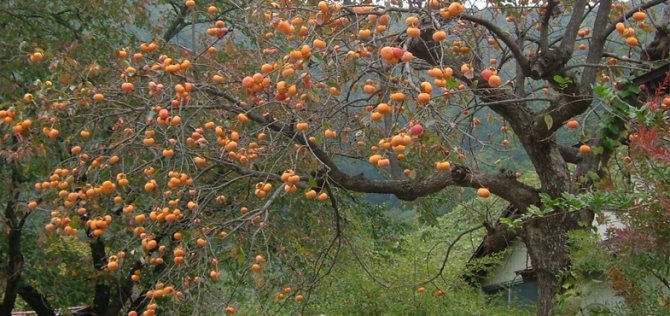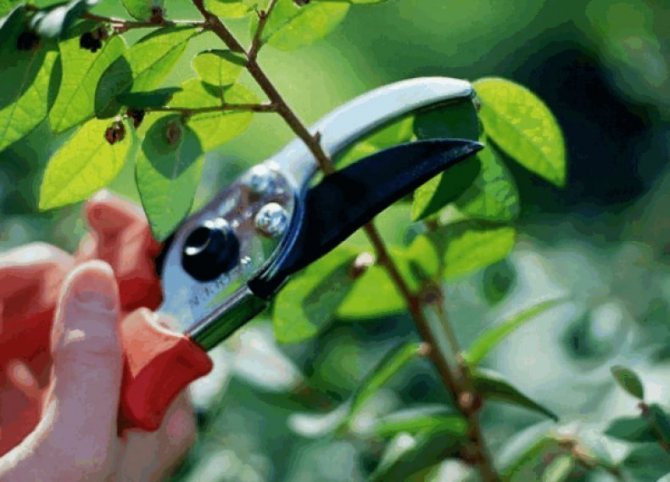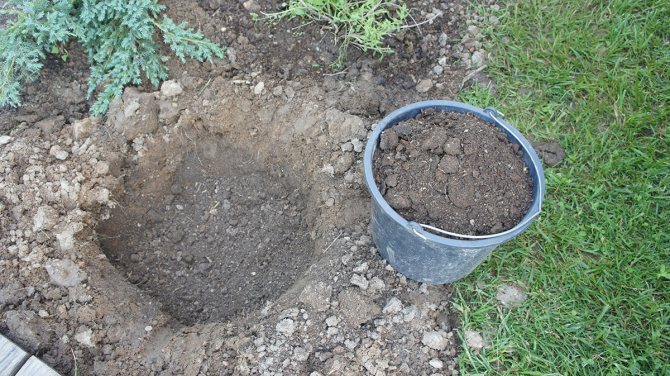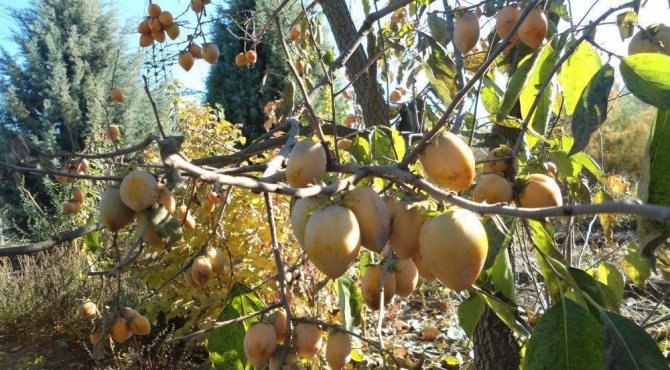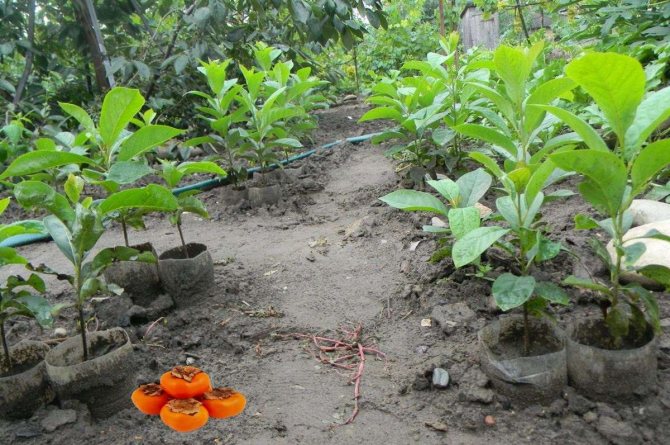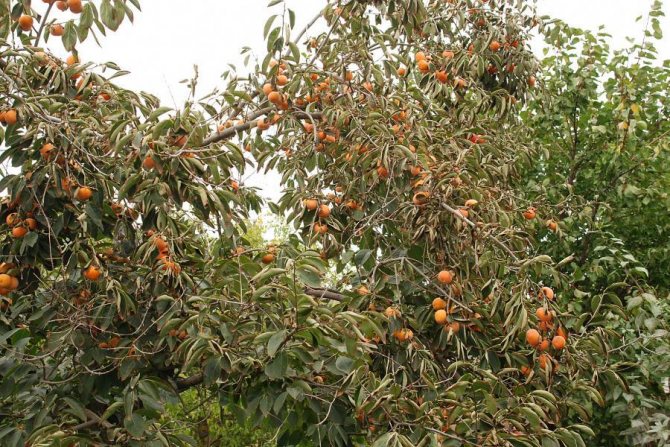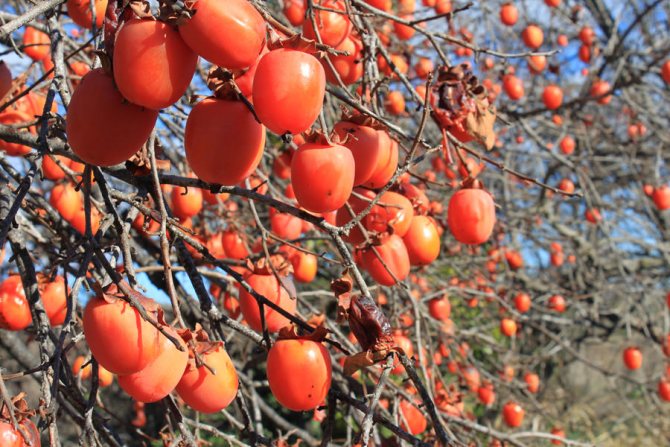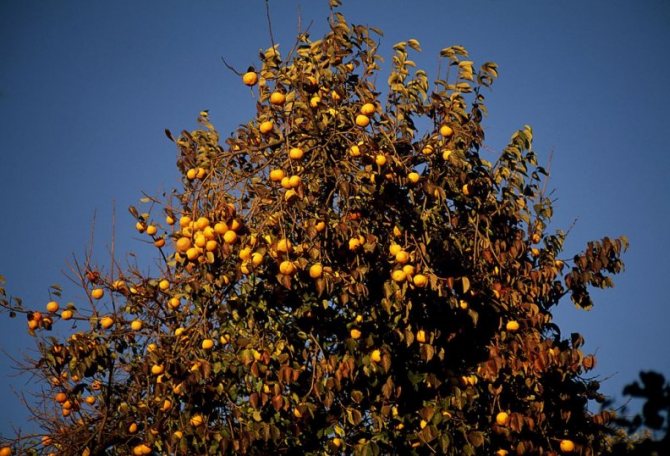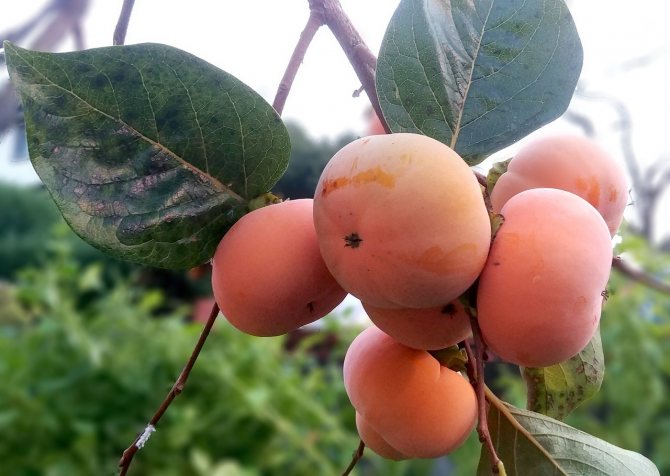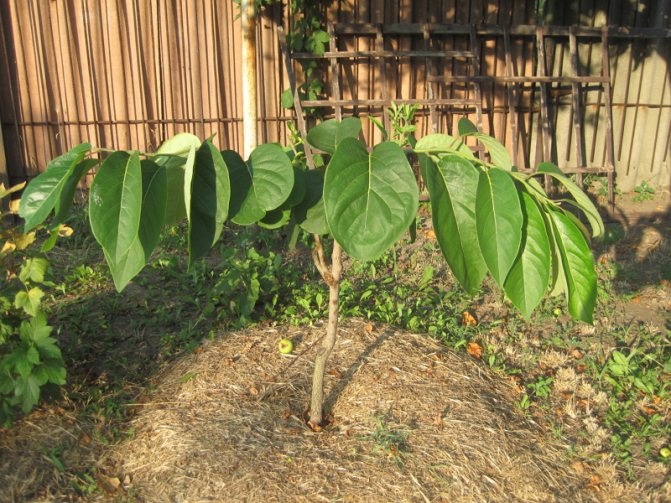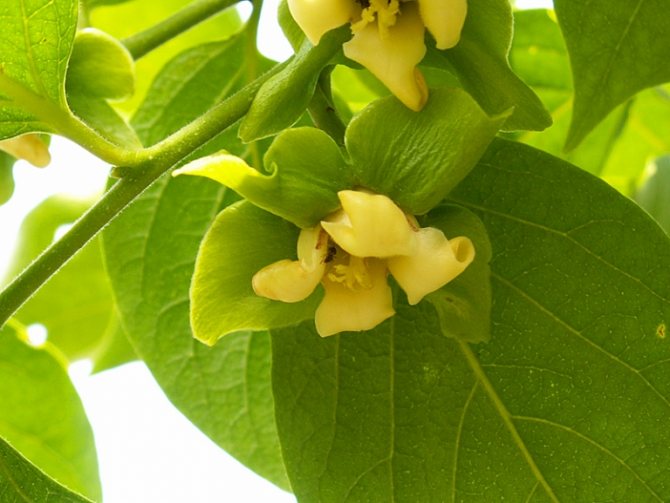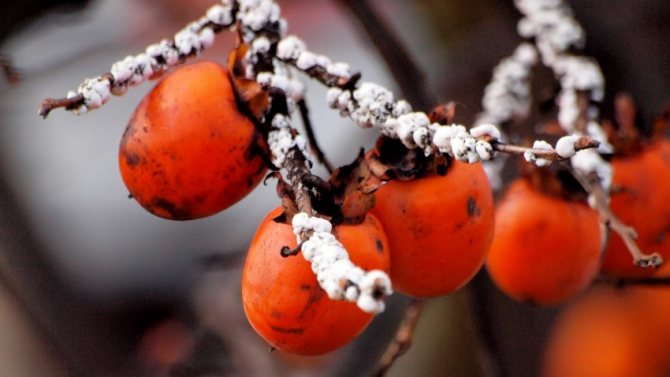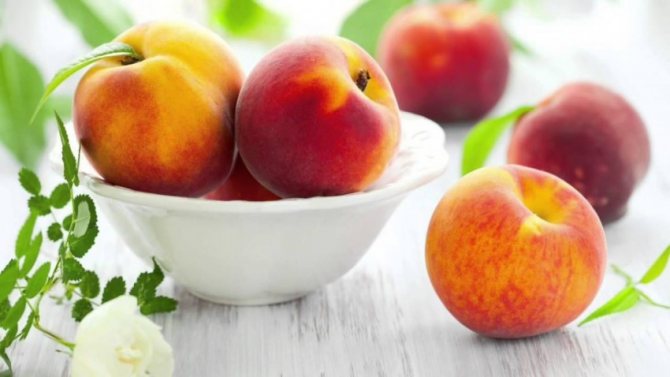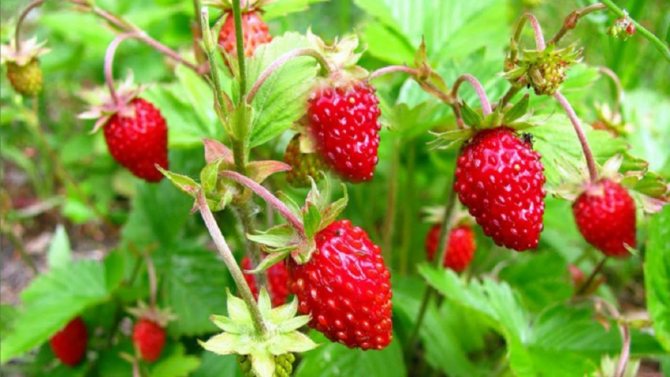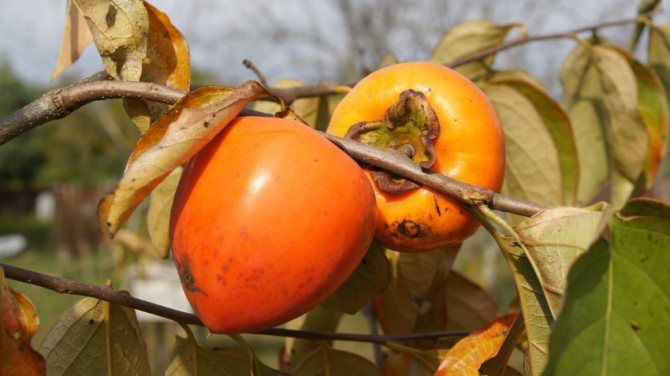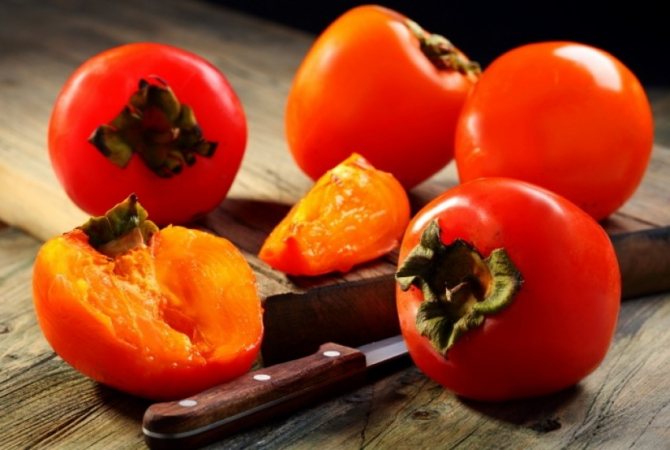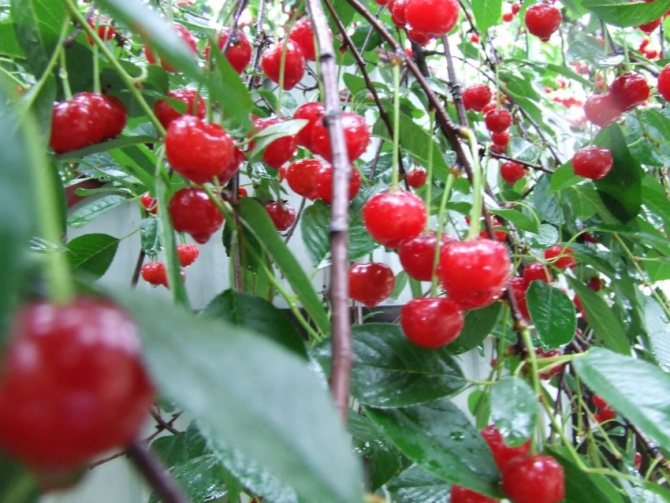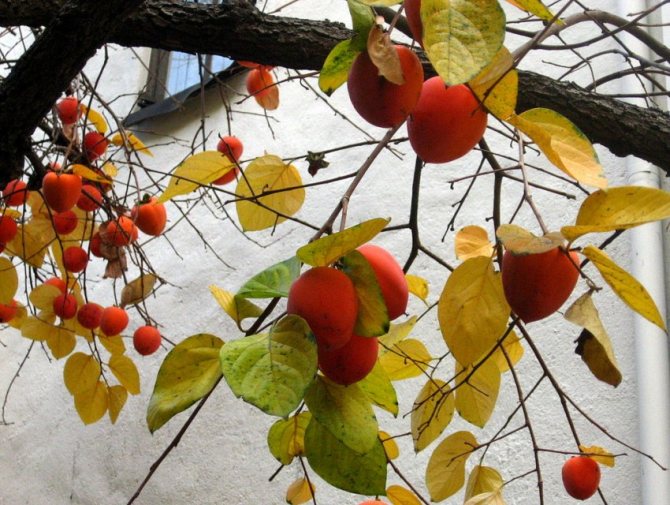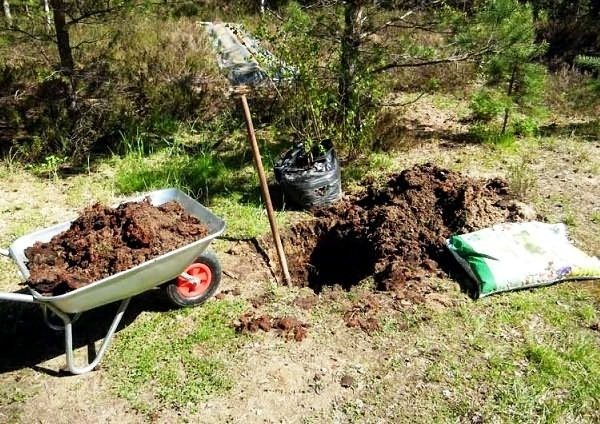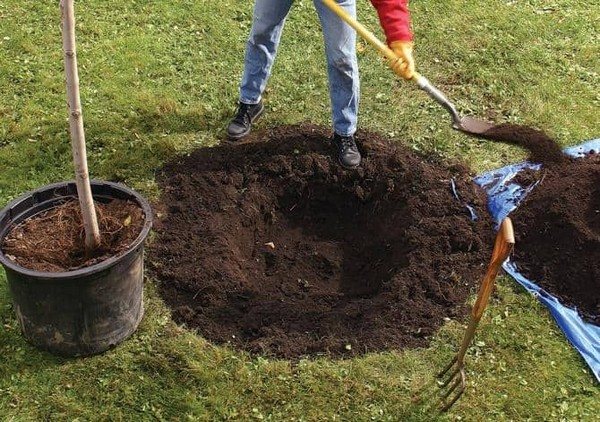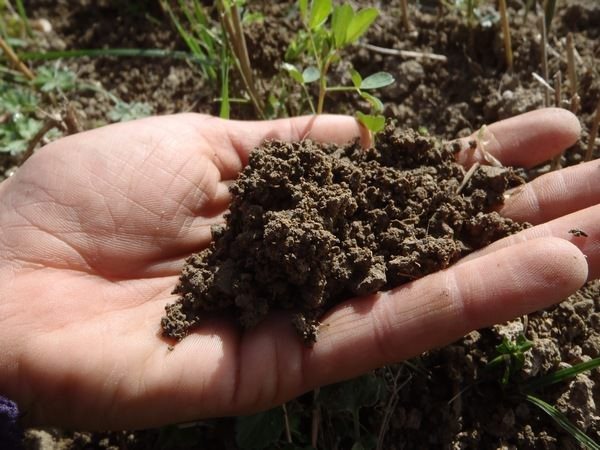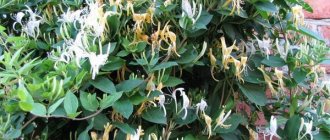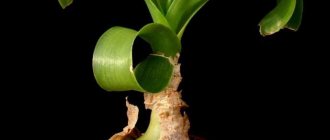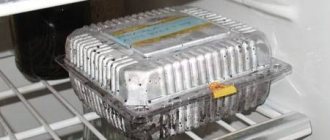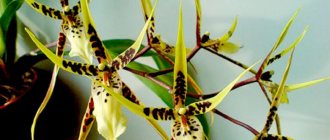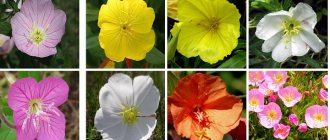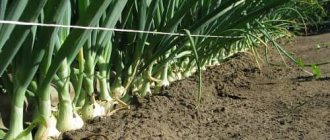- The stages of the breeding process
- Procurement of material
- Features of germination
- Transfer to the site
- Care rules
- Prevention of diseases and pests
- Persimmon pruning
- Persimmon grafting
- Conclusion
There are several ways to plant persimmons in your garden. The most popular and effective is the propagation of persimmons by cuttings. This method has an undeniable advantage - you get a strong plant with all varietal characteristics, which will bear fruit annually and delight with a tasty harvest.
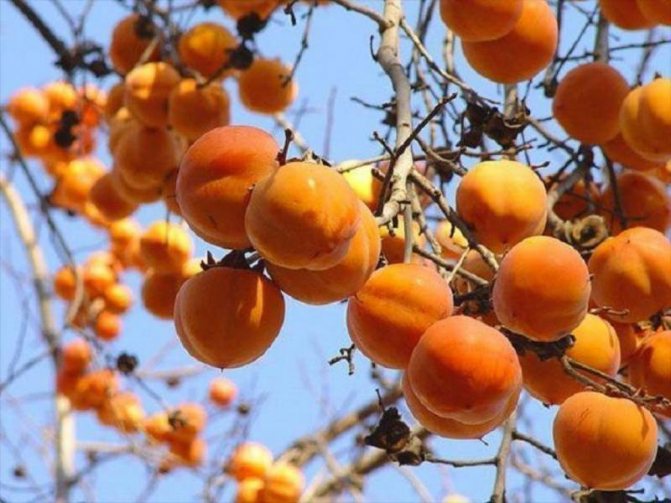
Propagation of persimmons by cuttings
Persimmons are propagated by seeds, seedlings and grafting.
Growing persimmons from seed.
This persimmon farming method is very painstaking and time-consuming. Seed germination is started in the autumn-winter period. The seed is removed from the freshly eaten fruit, washed and dried thoroughly. In a pot filled with earth, the seed is planted to a depth of 1-2 cm. The pot is covered with plastic wrap and placed in a warm place. A central heating battery is suitable for this. The pot is placed directly on it. Shoots should appear in 1-2 weeks. If this does not happen, it is useless to wait any longer.
To make the persimmon lose its astringency faster, it is moistened with alcohol and pricked in 10-15 places with a long needle. The needle is immersed in the fetus at half its height. You can do without alcohol, but then the result will appear 1-2 days later.
During the waiting period for seedlings, the pot is periodically checked. The plastic wrap is removed for a few seconds to ventilate the ground.
Make sure that the earth does not dry out. It should be moistened to a depth of 1.5 cm. Water the seedling as it dries.
When a sprout appears, the plastic "greenhouse" is removed. Persimmon sprouts are long, the stem reaches 10-15 cm. The seed can remain at the end of the sprout, pinching its tip. If after a few days it does not fall off, the persimmon may die. Therefore, the seed is carefully removed with a sharp knife, scissors or needle. If the seed is too tight, soak it. To do this, the persimmon is sprayed, covered with foil and removed to a warm place overnight. After that, it will be easy to remove the seed.
Persimmon grows quickly, so it must be periodically transplanted into larger and larger containers so that the plant's root system has enough space. If the roots do not have enough soil, the persimmon will stop growing, the leaves will turn yellow and the plant will die.
In summer, the persimmon seedling is kept in a well-lit place: on the balcony, in the yard. So that the leaves do not suffer from sunburn, persimmons are taught to light gradually, shading it at first.
During the growing season, 2 dressings are carried out: the first with organic, the second - with mineral fertilizers.
In October - November, the plant is removed to a room with a temperature of + 3-5 ° C, for example, in a cellar. The soil is mulched with wet sawdust. During the winter, they are periodically sprayed so that the soil in the pot does not dry out.
In mid-February - early March, the persimmon, together with a lump of earth, are transferred into a container 3-4 cm in diameter larger than the pot where it grew earlier. The plant is watered abundantly and exposed to light.
To form a tree from a seedling, pinch its top at a level of 30-50 cm. Thanks to this, lateral shoots will grow.
To form the branches of the second row, 2-3 apical shoots are left.When they reach a length of 20-40 cm, they are pinched. Thus, they form a tree with a height of about 1.5 m with a rounded crown.
For the summer, persimmons are transferred to a well-lit place protected from the wind. The tree is watered and sprayed regularly. During the growing season, mineral dressings are applied twice during the month.
In winter, the tree is kept at a temperature not higher than +10 ° C. The soil is sprayed to keep it moist, but waterlogging is avoided.
Propagation of persimmon seedlings
.
It is more convenient and easier to plant persimmons by purchasing ready-made seedlings. For 8 female trees, 1 male is enough. The trees are quite vulnerable, so they must be planted immediately after purchase. The seedling should be directed to the south by the grafting site. On heavy soils, the root collar of the tree is buried by 7-10 cm, on light soils - by 10-15 cm. The soil around the seedling is not trampled. After subsidence, the trunk circle is filled up with earth and watered abundantly. Tall varieties are planted according to the 7X7 m scheme, undersized ones - 5X3 m. The depth of the planting pit should be 20 cm more than the diameter of the tree root system.
Propagation of persimmons by grafting
.
Persimmons are rich in tannins, so the grafting must be done very quickly. Basically, they use the method of splitting or grafting with a kidney - budding with a sleeping or germinating eye. In the split persimmon is grafted in January - February, bud - in the spring, when the thickness of the stock reaches 0.7-1 cm, or in August. The most successful results are obtained with spring grafting.
Caucasian persimmon is well suited as a stock. It has a branched root system, and the varieties grafted on it tolerate transplanting well and give rich yields.
Scion cuttings are prepared in advance, before the start of sap flow. They are stored in a humid place at a temperature of + 2-3 ° C. When re-grafting persimmons with varieties of higher productivity or after grafting into the crown of a pollinator variety, the method is used in the split, in the side cut or behind the bark.
Cleavage grafting technology.
The stock is cut with a sharp knife in the center. A spacer is inserted into the resulting gap so that the incision does not close. Then a scion is prepared: at the lower end of the cutting, two identical oblique cuts are made, opposite each other. At the end of the handle, a wedge is obtained. The cut end is inserted into the slit up to the "shoulders". At the same time, make sure that the cambial layers of the scion and rootstock coincide. Then the spacer is removed. The scion stalk is caught in the rootstock. The vaccination site is tightly bound with electrical tape or film. A piece of bark is placed on the stock cut, the cleavage surface and the upper end of the cutting are covered with garden var. Make sure that the var does not fall into the gap. The side parts of the split, not covered with a strapping, are also thoroughly coated with pitch. After 2-3 days, the vaccination site is examined. The cracks that appear are re-covered with garden var.
For budding technology see the page "Reproduction of quince".
<2019. All rights reserved. The publication of site materials is allowed provided a link to Rural life
Characteristics of the variety
The persimmon tree of the named variety often reaches 5 meters. However, in some situations, it can stretch for another meter. The crown is quite wide and spreading. Therefore, it is necessary to choose the right place for the tree's "residence" - it should have enough space.
- The variety bears fruit without pollination - this is a plus. They refer it to the intermediate group. However, if you read the comments of experienced gardeners, you can conclude that pollination helps soften the fruits and make them tastier. Pitted fruits have more juiciness and are more pleasant in structure. So when you plan to breed several seedlings, it is advised to place at least one pollinator for every ten. For the purpose of pollination, it is permissible to spray persimmon with a solution of gibberellin.These manipulations will also help the tree not to shed flower stalks.
- Flowering occurs in the first decade of July. The flowers are painted in a delicate shade of pink, their shape is interesting - the petals are slightly curled.
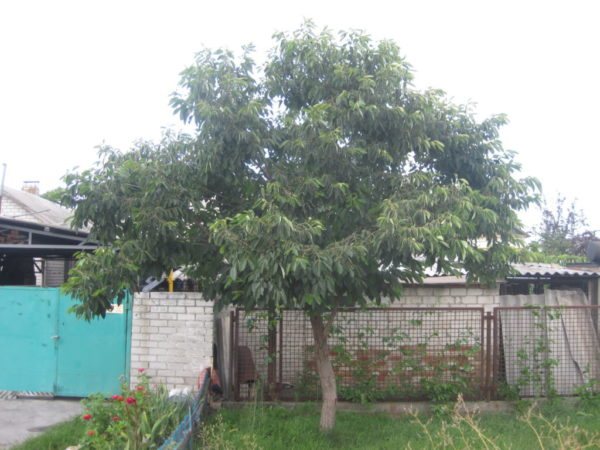

As a rule, persimmon Russian woman blooms in early July. - The persimmon foliage of this variety has a dark green color. The shape is slightly oblong. The structure is quite dense.
- The fruits are deep orange, round and slightly flattened. Their size is not too large. For the period of incomplete ripening, a white bloom can be found on the fruit.
- Fruits are considered ripe by the end of autumn. At this time, the foliage on the tree is no longer there, so exceptionally bright fruits remain hanging on it. The spectacle, I must say, is truly extraordinary.
- If the fruit does not have time to ripen, it will be tart and astringent. For ripening, you need to spread the persimmon in a cool place. After waiting for ripening, you will get a berry with excellent taste.


Fruits usually ripen by the end of autumn.
Important! Alas, storing persimmons of this variety will not work for too long. You can eat it only for a month. It should be noted that up to 80 kilograms of fruit can be harvested from one adult tree of this species.
The stages of the breeding process
To get a new tree, you need a well-ripened stalk, always from an already fruiting tree. It is not worth buying shoots from spontaneous markets or horticultural stores. It is better to ask a neighbor who already has a tree with fruits in the garden. The principle of planting and growing a plant both outdoors and at home is the same. The most suitable time for cutting cuttings is early spring, before the flow of sap begins.
Procurement of material
Each stalk must contain at least two eyes. All leaves on the shoots are removed. Cuttings are cut at a distance of 4-5 cm from the buds. All foliage, which will take moisture from the future plant, is removed.
Features of germination
Cuttings can be planted both in spring and autumn. Rooting cuttings at home involves an autumn procedure. In spring, cuttings are planted in open ground in the garden after the threat of the last frost has passed.
To germinate the harvested material, you will need a nutrient mixture and seedling boxes or volumetric pots. A layer of expanded clay (2-3 cm) or some other drainage material - pebbles, crushed stone - is placed on the bottom of the container. Then sprinkle with a nutrient mixture (garden soil plus humus in a ratio of 1: 3). Cuttings are planted in it and slightly trampled.
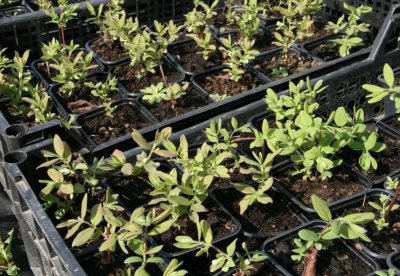

Further care of the cuttings is to ensure regular watering by means of irrigation from a spray bottle. Planting is placed in a place well-lit by the sun with the possibility of shading at noon. To accelerate the growth of roots and the process of building up green mass will help mineral and organic dressings, which are applied in turn - 2 times a month. The optimum temperature for keeping seedlings is 20-24 ° C.
The fact that the shoots have taken root will be evidenced by young leaves that have appeared with the arrival of spring. Such a plant can be domesticated or planted on a site. The best varieties for home growing are Hyakume, Jiro, Chinebuli and Zenjiaru.
Transfer to the site
In the southern regions, young plants are transplanted into open ground with the onset of stable spring heat. In the regions of the middle lane, cuttings are planted in early autumn so that the plant has time to take root before the onset of the first frost. The optimal dates are early or mid-September.
When planting, it is worth choosing a place on the south side of the house, where there are no drafts, since persimmon is a sun-loving plant.
They dig a hole 30 cm deep and 40 cm wide. Drive in a peg for support.A mixture of garden soil and compost (humus) is poured onto the bottom, then sprinkled with a small layer of dug earth and the roots of the plant are laid on top of it. The root system is covered with earth, trampled and watered. 1 bucket of water is consumed per plant. The near-trunk circle is spud with rotted manure.
When planting in autumn, the plant needs shelter for the winter. The top is covered with a cardboard box or wooden box.
Houseplants Directory
Persimmon tree in the room or on the terrace - so oriental. There is something warm, sweet and atmospheric even in the thought of creating such a beauty at home from just one cut. What is important to know about how to grow a tree from a cutting of a persimmon is the timing of planting, how to properly care for a persimmon and how to store the cuttings themselves - after all, without planting material, there will be no planting itself.
It is clear that in order to start, we need the persimmon stalk itself. I strongly advise you not to buy it in places where breeding materials are available, but ask your friends or neighbors - from someone who you know and have seen with your own eyes the fruits as a result of the development of a tree, and you also know or have noticed with at least one eye what some moments in the development of persimmons.
It doesn't matter if it grows in the house or it is planned to land in the open air, the principle of planting and care is almost identical.
Persimmon cuttings are believed to grow better. Its development is painless for your nervous system - each stage of caring for a persimmon tree is very simple and consistent.
Persimmon cuttings should be prepared in advance. It means that there are certain processes that take place inside the persimmon tree, so you need to choose the right moment and have time to cut the cuttings of the persimmon before the sap flow begins. Each cutting should have at least 2 buds, and all leaves can be removed. Do not cut too close to the kidneys - this will negatively affect the development of these same kidneys in the future.
At the beginning of spring, you can determine the place of planting persimmons and prepare for the fact that the time has come. Since this is an eastern representative, the best option would be to empty the southern or eastern windows for persimmon. Lighting plays an important role in the development of the entire tree, and add watering, a good potting mix, and fertilizers to this, and you will get an unsurpassedly beautiful persimmon bloom at first, and then also delicious fruits.


At home, if we are discussing this option, the cultivation of persimmons requires adherence to certain rules. Especially constantly pruning, since we must control the level and scale of development of our tree at home. Pruning is carried out after persimmon bearing. The cultivation of persimmons also rests on proper feeding, both of cuttings at the initial stage of growth of this tree, and of an already adult and developed representative of persimmons in the house, when it begins to actively lay buds for the development of inflorescences, that is, the described growing season.
It is during these announced dates that it is worth feeding the persimmon tree with ammonium nitrate diluted in a liter of water and superphosphate with potassium salt per liter of water. Top dressing should not be too intense - all is good, which is good in moderation - and the composition of the solution itself should not be too active: five grams per liter in the proportions of the two proposed solutions will be quite acceptable options for feeding cuttings or an adult persimmon tree that you successfully grow at home or outdoors.
Please rate the material you have read :)
Care rules
In the process of growth and development, young trees require proper and timely care.
- Throughout the growing season, the plant is periodically watered. The first moistening is carried out in early spring, then watering is carried out before and after flowering. This culture is also moistened during the period of ovary formation, which has a beneficial effect on the quality of the crop.The last watering is necessary in the fall - a month before the onset of cold weather.
- This culture responds well to feeding. In the second half of summer, the tree is fertilized with phosphorus-potassium preparations. At the end of summer, they are brought in by the foliar method. A solution is made of three components - potassium sulfate (0.5%), superphosphate (water extract 0.5-1.5%) and potassium permanganate (0.02-0.05%). Spraying is carried out every week with a gradual increase in concentration to the maximum value.
- Loosening increases soil aeration and improves oxygen access to the roots. This procedure is carried out 1-2 days after each watering.
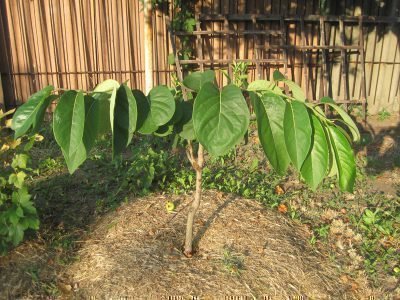

Briefly about preparations: location and soil
Any gardener should attend to the preparation of a site for planting young persimmons. What needs to be done for this.
| Sequencing | Description |
| It is good to fertilize the ground for persimmon with peat and loosen it up. As a result, it should turn out to be light in structure, providing access to air. As for the composition, the tree loves acidified soil. |
| Just before planting, it is required to form a hole with a depth and diameter of about 60 centimeters. The soil is placed at the bottom, where manure and river sand are introduced in equal proportions. It is necessary to let the hole air a little, the earth itself should warm up well. |
| During planting, in order to protect the young tree, a small support is placed in the ground. Thanks to this simple action, the persimmon will not be damaged by the wind. |
| After two days from the moment of airing the hole for planting, the tree is placed in it, the soil is lightly tamped next to the trunk. After that, it is recommended to pour water at room temperature. The area near the trunk is covered with foliage and dry grass - this helps the persimmon to take root and adapt well to a new place. |


It is worth preparing a place in advance for planting a tree.
Having planted a tree, you must follow a few simple rules regarding the further care of the plant. In the process of obtaining an adult from a young seedling, you need to take good care of it and devote enough time to it.
Prevention of diseases and pests
This is a mandatory procedure, which is the key to the health of the plant and its future fruiting. To protect the tree from diseases, a week before flowering, the crown is sprayed with Topaz or Horus. Before the onset of cold weather, additional processing is carried out with a Bordeaux mixture of 1% concentration. Ailing trees are treated with insecticides and fungicides of systemic action - Bordeaux liquid or Karbofos is also suitable. Processing is carried out in early spring, 2 weeks after flowering and in late autumn after leaf fall.
From the invasion of pests, persimmons are irrigated with Karbofos, the soil is shed with Aktara. In case of parasite infestation, the crown and soil around the trunk circle are sprayed with Bordeaux mixture - 3 times with an interval of 10 days.
How to plant a seedling step by step?
Saplings of all persimmon varieties in the south can be planted even in November. Here, the main criterion is that the earth does not cool down, and the frost has not yet begun. The root system must have time to get used to the new environment. As for the northern regions, it is necessary to plant persimmons here in the spring, when the frost will definitely not return.
It is recommended to start activities with preliminary digging and feeding. Often organics and superphosphates are used for fertilization. It will also be correct to adjust the acidity, since persimmons love a neutral environment. When the site is ready, it is required to form a pit for planting there, its dimensions are 60x60x60 centimeters.


It is recommended to apply top dressing in advance
Then you need to fill the hole with a drainage layer and a fertile mixture. It is made from the same proportions of humus, compost, river sand and high moor peat.At the end of the manipulations, the pit is covered with a black polyethylene film and left for several weeks to create a special microclimate. Only after that, the shelter is removed and the landing itself begins.
First, you need to place a peg made of wood with a burnt edge in the center of the recess. This action is very important, because it saves from decay processes in case of decomposition of the support.
Interesting fact: if persimmons are not ripe and have a nasty astringent taste, they must be put in a plastic bag with apples. Together, these fruits will quickly reach the desired condition. The reason is that apples release ethylene, which provokes accelerated aging of the tissue structures of the fruit.
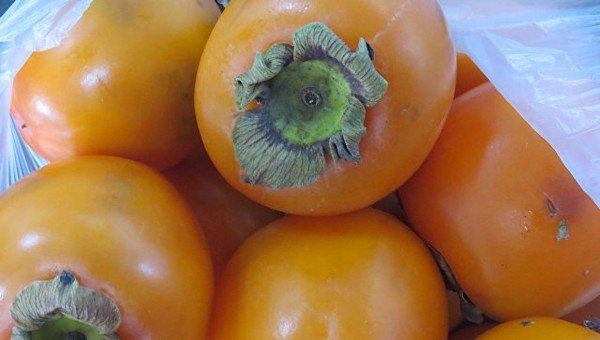

In order for the fruits of persimmon to ripen, it is worth putting them in one bag with apples.
Important! It doesn't matter what kind of planting material you bought - with open or closed roots. Before rooting a young plant, be sure to let it stand in a container of water or provide good watering.
Exposed roots need to be re-examined, monitoring for damage or drying out. Then you need to treat the root system with a clay mash. At the end of all actions, the roots are immersed in a planting pit, straightened, watered well and sprinkled with fertile soil. Do not forget: the graft site should be buried by 5-10 centimeters in the grafts.
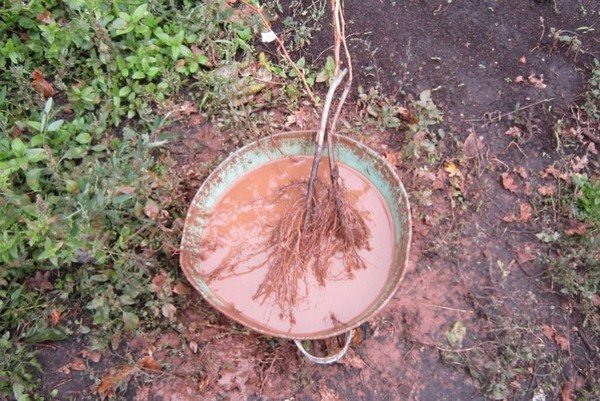

It is recommended to treat the roots with a clay mash
Persimmon pruning
As the experience of gardeners shows, the smaller the size of this plant, the higher its ability to survive. Trimming the central conductor is carried out at a height of 80 cm. This technique allows you to ensure a balance between the aboveground and underground parts of the tree.
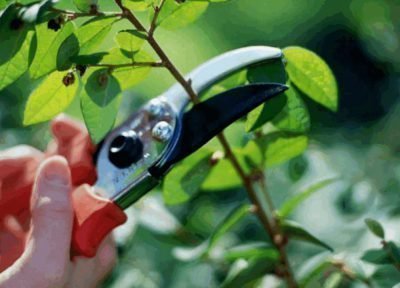

The main task of the gardener is the correct formation of the crown, which in the future will allow you to get not only a beautiful, but also a fruitful tree. For this culture, the sparse-tiered form is best suited, which implies a decrease in the height of the central trunk and the number of tiers:
- To stimulate the growth of skeletal branches, remove all shoots that thicken the crown. Branches that retard the growth of the central conductor are also subject to cutting. The main branch is pruned into a bud to stimulate its vertical growth. 2-3 skeletal branches are left on one tier. The optimal distance between them is 10 cm.
- Shoots of the second tier are left between the branches of the first row.
- The next year, the skeletal branches are trimmed - they are shortened by 40 cm.
- After the first fruiting, light pruning of the tree is carried out, leaving the annual shoots intact. After 1-2 years, fruits will appear on them.
- After the tree stops young growth, a rejuvenating haircut is performed for it. In the year of this operation, the tree does not bear fruit - all the strength is spent on recovery.
- Sanitary pruning of persimmons is carried out annually in early spring - all damaged, frozen and dried branches are removed.
Features of chocolate persimmon Korolek
Everyone has heard of the Korolek persimmon variety, it is the most common in stores. Most of the inhabitants are sure that this is almost the only variety of persimmon, but this is a delusion. Also, many gardeners are convinced that chocolate persimmon and Korolek are one and the same. This misconception often leads to errors in cultivation and to confusion of varietal traits, gardeners are disappointed with the taste of the fruit and the size of the crop, although their actions could have influenced this.


Persimmon grafting
The most effective way to achieve high yields from a tree is to graft persimmons. In addition, such manipulation makes it possible to diversify the fruits.
You can pinpoint persimmon to other types of culture - varieties Virginia, Caucasian, Fig or Ordinary.
Vaccination technique:
- a T-shaped incision is made on a rooted plant (rootstock);
- a freshly cut cutting (scion) is inserted into it;
- the places of the cuts are tightly pressed and wrapped with transparent film or electrical tape.
Usually, a plant that blooms and bears fruit is used as a scion. A stalk of another plant is grafted onto it, which has good immunity and a strong root system.
From one variety, you can get a completely new one. To do this, remove all skeletal branches on the tree, clean the cut points, make T-shaped cuts and insert 1-3 cuttings into each. The contact points are wrapped with electrical tape so that the binding material does not cut into the bark of the tree, otherwise the stalk will not receive nutrients from the mother plant and will dry out over time. The binding points are lubricated with garden varnish and left in this state for a month. Late February or early March is the best time for this procedure.
After a month, you can watch the result - if the branches have not dried out and the first leaves have been released, the process was successful. Carefully remove the harness so as not to damage the graft bark. Further caring for a tree is no different from caring for a varietal plant.
Persimmon: planting and growing
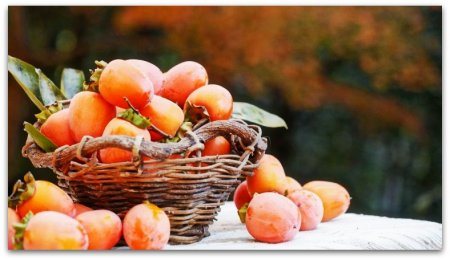

In November, retail chains are filled with a bright yellow, orange, brownish berry called persimmon
... And every fancier gardener comes up with the thought - "shouldn't they try not to grow it themselves." The technology of its cultivation and care is more complicated than that of other crops, but if you wish, nothing is impossible.
But first you need to turn to the berry itself called persimmon. When ripe, its pulp becomes tender and sweet in taste after the first frosts. It is also rich in various beneficial properties. They even prepare tonic drinks from it, which says a lot.
In general, China is considered the birthplace of persimmons. It was from there that it began to spread throughout the world, gradually capturing new territories. But it became most widespread starting from the 19th century, when it began to more actively penetrate the European continent.
Translation of the word "persimmon" means - "fruit of the gods." There are more than four hundred and fifty varieties of this berry. Moreover, in addition to the berry itself, almost all parts of this plant also have useful properties.
Persimmon berries are very nutritious - and are often recommended for those who want to maintain proper nutrition, go in for sports and even children. In addition, with constant consumption, it helps to strengthen the gastrointestinal tract. It has a preventive effect on the cardiovascular system. Thus, we can say with confidence that persimmon is a storehouse of useful and valuable elements. And its cultivation is not only interesting, but also useful.
general description
Persimmon, as a fruit tree, is known in many countries of the world, it is grown because of the beneficial properties of fruits, as a decoration in the garden. Depending on the variety, and there are about 200 of them, the tree can reach up to 12 m in height. Persimmon is a perennial tree that can bloom for up to 500 years and belongs to the Ebony family, a class of dicotyledonous plants.
The leaves are dark green, glossy on the outside and matte on the bottom. The shape is oblong. The flowering period is from early May to mid-June, the tree has: male, female and mixed inflorescences, their shade is pale yellow. The fruits are sweet, fleshy with a tart, astringent pulp. The ripening period of the crop falls in mid-autumn.
general information
The Ebony family includes several hundred types of persimmons, including the Korolek persimmon, which is called differently:
- Chocolate persimmon;
- Chocolate bar;
- Chocolate pudding;
- Black apple.
The names indicate the main distinguishing feature - a dark color. But there is also a close variety - Zenji-Maru, which was nicknamed Shokoladnitsa, with which confusion often arises.
The original name of the chocolate Korolek variety is Hiakume, indicating its place of origin - China and Japan, where it appeared about 2000 years ago.Since the middle of the 19th century, these fruits have spread throughout the world - America, the Mediterranean, Africa, the Caucasus, Ukraine. On the territory of Russia, Korolek persimmon can be grown not only in the southern regions, but also in the middle lane.
The tree on which the chocolate persimmon grows is similar in description to a cherry. The height of the tree varies from 9 to 12 m, it is influenced by the age of the plant, the tree has a dark bark. The color of oblong leaves is heterogeneous, on one leaf there can be several shades of green at the same time.
The tree blooms in May, burgundy, green or yellow flowers are pollinated by insects that fly to a strong smell. After pollination, the color of the fruit changes - it becomes darker, the taste also changes to more juicy, the astringent sensations disappear.


The ovaries are formed in July, by October the harvest of the Korolek persimmon is fully ripe, it can be harvested for a month, there is a danger that, due to the large harvest, many fruits will fall to the ground. The peculiarity of the tree is that it sometimes gets rid of unnecessary ovaries. When harvesting, you must take good care of the fruit, leave the stalk on the tree. Store them in a dark and cool place.
The fruits have a round and slightly flattened shape, weigh 700-800 g, their diameter is 10-12 cm. The more ripe persimmon, the more intense the color of its skin becomes, the flesh becomes creamy, the fruit is soft to the touch. More than 10 elongated seeds are hidden inside the fruit.
Composition, benefits and harms of chocolate persimmon
Chocolate kinglet is one of the lowest-calorie varieties, it contains just over 50 kcal per 100 g, about 20% carbohydrates, which makes it an excellent basis for weight loss diets. One fruit is 80% water. This persimmon is a real storehouse of nutrients:
- pectin, which is found in abundance in fruits, is useful for people suffering from problems with the gastrointestinal tract;
- vitamin A, which improves vision, vitamin C strengthens the immune system, as does ascorbic acid;
- iron, which has a beneficial effect on hematopoiesis;
- calcium and phosphorus, which strengthen the joints;
- magnesium, which helps in the well-coordinated work of the excretory system;
- beta-carotene, which has a strong bactericidal effect, reducing the negative effects of the environment;
- acids, including betulinic acid, which reduces the risk of cancer.
Also, Korolek has a positive effect on the heart and blood vessels, the nervous system, the female body during pregnancy and menopause. But not everything is so simple when eating chocolate persimmon: patients with diabetes, serious ailments of the digestive system, it is better to refrain from this fruit.
Sometimes for this category of people, limited doses are permissible in agreement with the doctor. The tannin inside the fruit can provoke constipation, so it is better for those suffering from this ailment to wait until the fruit is fully ripe, when there is not much tannin in them. Do not eat unripe fruits.
The Korolek variety is excellent for processing, it is used for desserts, drinks, added to pies, used as a sauce, and the resulting juice is a useful remedy for vitamin deficiency.
Also, this persimmon is used in cosmetology, it is an important component of many creams, shampoos, masks, some of which you can prepare yourself. It is not uncommon that coffee is made from fruit seeds after processing.


The ratio of chocolate persimmon and persimmon Korolek
There are differences between persimmon Korolek and Chocolate, proving that they are two different types:
- the Korolek variety does not knit, there is no astringency in its taste, unlike Chocolate persimmon;
- Korolek has a lighter skin, it is orange, and not dark brown like Chocolate;
- in the Korolek species, fruits appear from male flowers, in Chocolate - from female flowers, two species cannot be found on the same tree.
Propagation by cuttings
Reproduction by green cuttings is carried out in June, when new shoots are actively blooming. To get seedlings from green twigs, you need to prepare a planting site:
- it is required to dig a hole, the depth of which is 50-60 cm, width is 90 cm: the length should correspond to the number of cuttings;
- drainage should be poured into the bottom of a trench or a specially prepared box in the form of sea pebbles or broken bricks;
- pour a layer of coarse sand;
- fill up to the top with a substrate from the soil, buckets of wood ash, 10 kg of humus and wood dust;
- watering with a solution of potassium permanganate as a disinfection;
- Pour coarse sand on top of the substrate with a layer of 5 cm.
Harvesting material for propagation by cuttings is carried out in the evening. Branch pruning is performed according to the criteria:
- the content of 3 internodes is mandatory;
- there should be no lignification, the entire shoot is only green;
- cut off shoots with a straight cut from above and beveled to the side from below;
- between the cut and the kidneys, a distance of 1 cm is required.
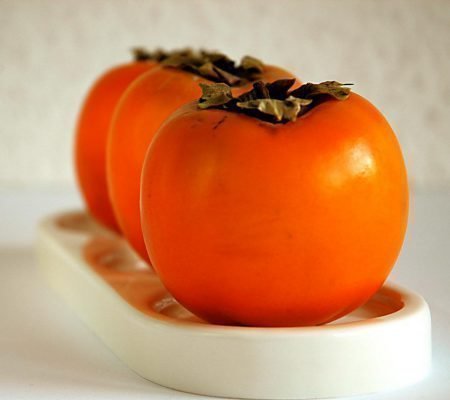

After cutting, the shoots are placed in a growth stimulator for 12 hours. To do this, take the drug "Heteroauxin" in the amount of 3 tablets per 1 liter of water. The container with cuttings is removed in a cool, shaded place. Before planting in the ground, the shoots are washed with water, and then carefully inserted into the prepared place, 3 cm deep into the sand.
To create greenhouse conditions, the cuttings are covered with foil. Persimmons are watered every day, making sure not to overmoisten the substrate. The cuttings themselves are irrigated from a spray bottle 5 times during the day so that droplets do not roll off them. After 14 days, the covering over the green plants is removed and fertilizer is applied in the form of liquid manure, 0.5 kg per 2.5 liters of water.
The next spring, you can replant the seedlings to a permanent place.
Advantages of the variety Rossiyanka
In 50-60 years in the Nikitsky Botanical Garden A.K. Pasenkov, crossing virgin and oriental persimmons among themselves, received an interspecific hybrid plant, which showed many advantages when compared with its predecessors who prefer warmth.
- The plant gets used to the harsh and cold winters typical for the middle zone of our country. The Russian woman copes with temperatures down to minus 30.
- The fruits are tied in any case, no matter what gender the tree is.
- The first fruits are formed quite quickly - just a few years after planting a young plant in a permanent place.


Such a plant quickly gets used to cold weather. - During the growth of persimmons, there is no need to use processing chemicals. The bred hybrid is resistant to fungi and diseases. This is very important, because as a result, the fruits are environmentally friendly, which means they have a high value.
This specificity of the Russian woman will help to get a strong and healthy plant in the difficult Russian climate, which can be attributed to the Moscow region. If you plant persimmons correctly and take care of them responsibly in the future, you will get a good harvest.


The Russian woman can be grown in almost any region of Russia, since she easily copes with any climate
Grafting process
Grafting persimmons, like other fruit crops, requires special skills in plant growing. It is necessary to strictly adhere to all the rules and terms of the scion.
You can paint a persimmon on a tree of another variety, but such a plant will not last long, because the wood will develop unevenly. As a result, the appearance of the hybrid will resemble a thick tree with a thin stem.
Grafting of persimmon seedlings should be carried out on trees of the same species, then one can expect that the tree will bear fruit and develop normally. If you are going to plant persimmons on another variety of fruit trees, you will need to follow some rules.
- Grafting shoots only on plants of the same ripening period, late-ripening varieties are best suited for the stock.
- Trees must be climatically adapted: frost-resistant, drought-resistant.
Procedure time
Each gardener independently chooses the timing of the vaccination, the procedure is carried out year-round. The best time for grafting a fruit tree is in the spring. Starting in March, you can start the procedure, which is carried out in order to rejuvenate, improve the fruitfulness and quality of the fruits, to obtain various fruits on the same tree.
Shoots for vaccination should be prepared in advance: they are cut in the fall the day before vaccination. In autumn and winter, it is quite problematic to make a stock because of the cold weather and the persimmon tree falling into hibernation. If the vaccination is carried out in the fall, then it is better to carry it out before mid-October, so that the shoot has time to adapt to frost.
From what period the summer vaccination is carried out: from mid-June to the end of August. For the procedure, you will need garden tools:
- knife for trimming thin shoots;
- copulated knife for cutting wood;
- secateurs;
- flat screwdriver for splitting;
- insulating tape.
Rootstock trees
When choosing trees for a persimmon rootstock, it is best to focus on the following plants: figs, apple trees, Virginia persimmons and Ordinary persimmons. Instructions for the process of grafting to an apple tree, the "copulation" method:
- the diameter of the rootstock and scion should be between 7 mm and 10 mm;
- on both cuts, notches are made 1 cm long;
- the cuts are connected and rewound with electrical tape;
- put a bag on top of the pinned branch.
Description of the grafting method "for the bark" to figs:
- the process of grafting for the bark is carried out on the thick branches of a tree that is already about 5-10 years old;
- stock up to 20 cm, scion up to 2 cm;
- the cut should be thoroughly cleaned with a knife;
- the handle is cut along an oblique line, leaving a cut 4 cm long;
- on the rootstock, a 5 cm incision is made in the bark so that the cut cutting is inserted there;
- process the cuts with garden pitch and isolate.
If you are looking for tree varieties that are best suited for grafting - without a doubt, Virginia persimmon or Common persimmon, you can use the split grafting method:
- the diameter of the rootstock and scion must be from 7 mm;
- a branch that will serve as a stock is cut at a height of 40 cm from the trunk or the ground;
- in the rootstock, make a split 5 cm deep, into which a cutting is inserted, cut obliquely;
- wrap with electrical tape for bonding.
Persimmon "Russian woman", persimmon seedlings planting and care at our dachas
What kind of plants, trees and shrubs are not grown in our gardens. With a standard set of apple, pear, plum, etc. all clear. Every self-respecting gardener necessarily grows them in abundance. But what about the exotic? For example, a persimmon unusual for our region? Do you think this Asian plant cannot take its rightful place among our locals? Can! And for some lucky ones it takes about 10 years.
The breeders helped us to tame her Ukrainian colleagues. They bred the "Rossiyanka" persimmon variety. It is fully adapted to our difficult climatic conditions. However, the Russian colleagues are not lagging behind, they also work and have decent results. Now planting persimmons is available to us.
Taking care of the tree
Correct and timely pruning of persimmons affects the further development and fruitfulness of a tree grafted or grown from a cuttings. Formative pruning is very important in the early stages of development.
They begin to form the crown when the seedling reaches 90 cm. The lateral shoots are cut, leaving 5 pieces of shoots forming the skeleton, including the grafted cutting, if any. In other years, cut off branches based on their size, all shoots above 30 cm are shortened to 15 cm.
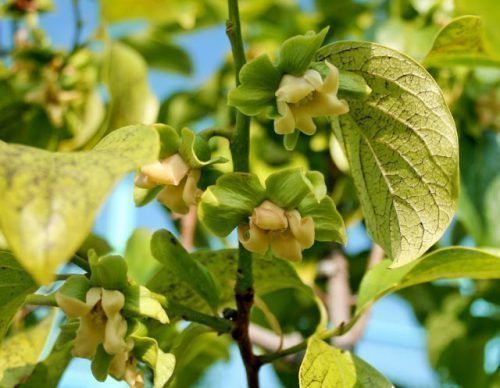

Pruning is also carried out to rejuvenate the crown. Cut out dry, damaged, improperly growing branches.
How to care for a tree?
Let's now talk in detail about all the actions that will allow you to get a strong and healthy tree, as well as a rich harvest.
Cropping and shaping the crown must be done without fail.
- The growing season is of great importance. At this time, it is required to loosen, if necessary (at least 5-6 times) and water the soil well. Be sure to take care of the acidity of the earth necessary for the plant. To this end, it is advisable to pour the persimmon with water, to which a little vinegar has been added.
- Young trees need to be constantly watered. The soil should never be dry. The roots may not survive the drought, so the tree will simply die. If the weather is hot, you need to especially carefully monitor the moisture content of the soil.
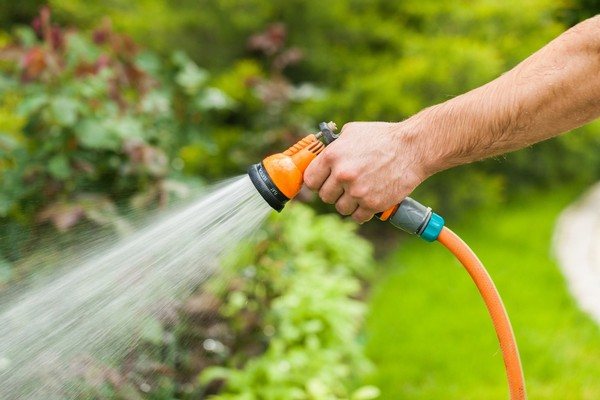

Young trees should be watered frequently. - The introduction of dressings for persimmons is required. However, in the early years this is done carefully - there is a risk of applying too much fertilizer and burning the roots. The optimal amount of feeding for a seedling is up to 15 kilograms of mineral and organic substances, for an adult - no more than 20 kilograms.
- Crown pruning and shaping should be done with great care in the early years of a young plant's vigorous growth. Excess shoots and twigs are removed (this is especially true for those that are heavily scattered on the sides, and do not look up). Thanks to this, the persimmon will save energy for further growth.
- Very relevant diseases for this culture are the Japanese false shield and gray rot.
- Although this variety is loved by gardeners for its ability to tolerate cold, young plants must be protected from drafts, cold winds and severe frost. For this purpose, shelters designed for the winter are used.


It is better to cover plants for the winter to avoid strong winds, frost
Spread
The homeland of persimmon is India, southern China, North America. This thermophilic plant prefers sunny, humid regions with mild winters and temperatures no lower than -2 ° C. The greatest species diversity is in Southeast and South Asia. Areas where persimmon grows:
- Malaysia,
- India,
- Korea,
- China,
- Philippines,
- Thailand,
- Sunda Islands,
- Ceylon,
- Sri Lanka,
- Japan.
Fruit trees have been introduced, cultivated in areas with a suitable climate:
- Italy,
- Spain,
- Turkey,
- Iran,
- Mexico,
- Brazil,
- New Zealand,
- South Africa.
In the regions of Central Asia, Transcaucasia, on the territory of the Krasnodar Territory of Russia and the Crimea, Caucasian persimmons are grown.


Bloom
Persimmon flowers are unlike anything. They differ from apple or pear, as they have an unusual shape, they are also characterized by a large size and dense petals. Flowers are divided into male and female. Each of them has its own characteristics in structure and form. The female sex is voluminous flowers with large and dense petals, the calyx has 4 leaves. Male flowers are small and shaped like a bell, which is arranged in the form of brushes of 3 flowers. They have a greenish-yellow creamy shade, which is barely noticeable, as it merges with the leaves.
On the branches, you can see from 1 to 5 flowers during the awakening of the plant in March. Sometimes bisexual flowering occurs. The presence of seeds in the pulp depends on the pollination of the flower. In parthenocarpic varieties, this process does not occur and the seeds do not develop. And if the persimmon is still pollinated, then the fruit will grow with seeds.
The flowers hide among the branches and have a pleasant smell that resembles a cough lozenge. The aroma during this period is oily and tart. The flowers, although not too noticeable due to their green hue, but insects find them and pollinate them.
Possible growing problems
The Russian woman does not suffer from fungal diseases. The main danger for her is the scale insect and the false shield, feeding on the sap of the leaves, as well as any caterpillars (scoop butterflies, white hawthorns, and so on) eating greens.
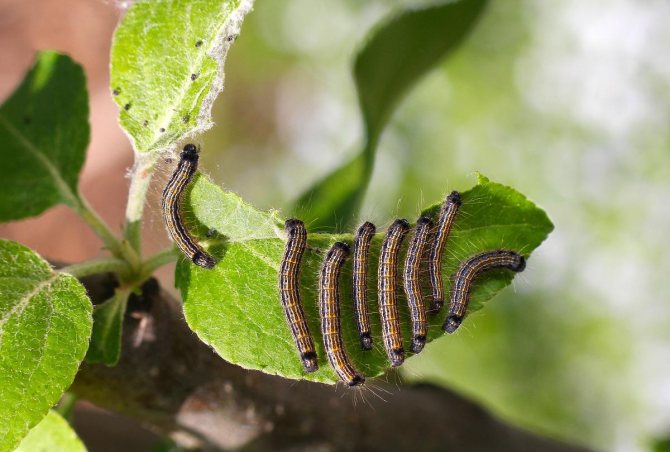

Any caterpillars are distinguished by their rare gluttony and omnivorousness - the greenery on the fruit trees attacked by them disappears literally before our eyes
The scabbard and pseudo-scabbard are rounded grayish-brown "outgrowths" on the tree. To get rid of them, they use Aktara, Fufanon. Caterpillars are destroyed with any general action insecticides - Actellik, Tanrek, Mospilan. Adults will be scared away from the trees by Lepidocid, Bitoxibacillin. Any chemicals can be used if there is at least a month left before harvesting.
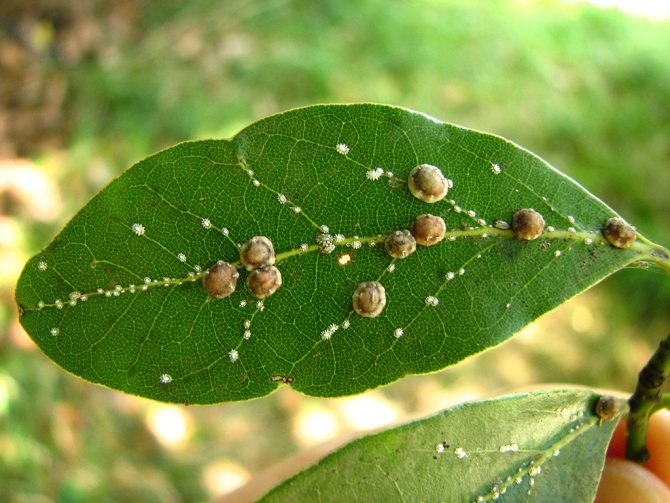

Folk remedies against scabbard and false shield are ineffective: upon finding a pest, immediately use insecticides
How is the plant pollinated?
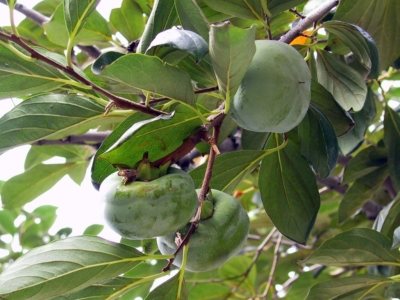

In general, persimmon belongs to insect pollinated plants. For pollination, 1-2 male plants are planted among 5-10 female plants. In the presence of a multi-house variety, it is advisable to grow 2-3 trees side by side to cross-pollinate them with each other, since not all varieties develop fruits with self-pollination.
There are also varieties on which fruits develop parthenocarpically, i.e. without pollination. For such trees, the presence of a male plant is not necessary, however, with pollination and the formation of seeds in the fruits, their taste improves.
Plants can be pollinated on their own by transferring pollen taken from the stamens of a male plant to female flowers. This is usually done with cotton pads, tampons, or sticks.
Persimmon is a heterosexual (or bisexual) plant, warm and moisture-loving. Flowering occurs in May-June on the shoots of the first year of life. Fertilization of flowers is carried out by insects. Some varieties are capable of producing fruits without direct pollination.
Outdoor cultivation
In the garden, persimmons are planted when the soil warms up to 14-15 ° C. The root system is pretreated with a growth stimulant. To ensure normal fruiting, it is recommended to prepare several trees. One of them must be masculine. The distance between plants should be at least 4 m. Planting algorithm:
- The pits are prepared with a depth and width of about 70 cm. 20 cm of broken brick, expanded clay or gravel are poured onto the bottom.
- The soil from the holes is enriched with humus or compost, 200 g of nitroammofoska are added.
- A support peg is driven into the center of the hole. A mound of soil is formed at the bottom, a seedling is placed, carefully covered with the remaining soil. The root collar should be flush with the surface.
- In a radius of 70 cm around the trunk, a circular roller is formed from the soil to retain moisture. Water the seedling with 30 liters of settled water at a temperature of 20 ° C. When it is absorbed, the plant is tied to a support.
- Trunk circles are mulched with chopped straw, needles or sawdust.
Brief botanical information - in which countries persimmon grows
Man plants his favorite fruits and vegetables wherever the climate and soil allows. Selection helps in this, which produces frost-resistant or drought-resistant plant species. Thanks to breeders, it expanded its habitat and persimmon. Initially, it grew in China, Japan and the Indomalay region, spread to America and Eurasia, and settled in Australia.
Orange fruit comes to Russian counters more often from countries such as Turkey, Israel and some others. Crimea also joined the ranks of those who can grow "food of the gods." With the help of selection, varieties adapted to our winters have been bred.
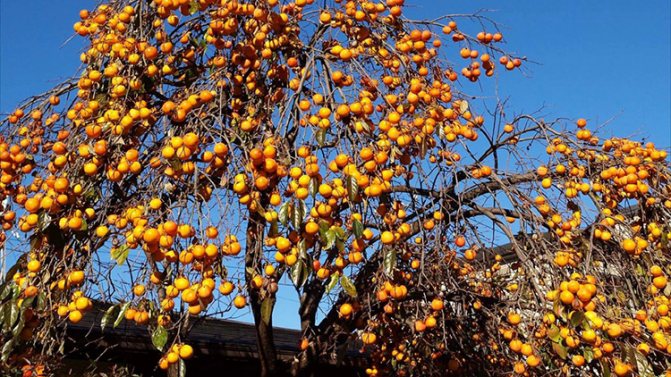

Persimmons are grown in Ukraine: the varieties Rossiyanka and Nikitskaya Burgundy have taken root there.
Preparation of planting material
To see how the persimmons grow, the first step is to plant the seeds. The seeds for planting are taken only from ripe fruits. First, be sure to rinse the bones from the remnants of the pulp and dry them. Then there are two options. The first is to immediately lower the seeds into a prepared and previously disinfected soil mixture. In this case, seedlings will need to wait up to two weeks. To speed up the sprouting process a little, you can pre-germinate the seeds. They are placed between two layers of cotton wool and placed in a warm place. Cotton wool needs to be moistened as it dries.As soon as it becomes noticeable that the seeds have sprouted, they are moved into the prepared soil. From this moment, carefully observe how the persimmon grows. The first sprout often appears with a bone at the tip. It is necessary to carefully free the plant from it, otherwise it may dry out.


How to prepare a tree for wintering?
This nuance is of particular importance. Although mature trees of the Rossiyanka variety tolerate winter without problems, young plants can suffer from frost. They need special training.
At the end of rooting, gardeners recommend spilling the trunk with soil, and if frosts are expected soon, it is necessary to cover the seedling with a wooden box, filling it with earth, sawdust, or insulate it with foam. The crop trunks are mulched with a thick layer of peat or humus.
In the future, it is also necessary to organize the wintering of the trunk and skeletal branches. Gardeners recommend covering the shelter with a material that reflects light.


It is important to prepare the tree for winter, especially if it is young.
In the south, trees of "venerable age" are covered with mulch or lime whitewash. However, they notice stem injuries even on those varieties that are not afraid of frost - the bark flakes off, and the cambium dies.
Experienced experts advise to attend to the genetic characteristics of the rootstock and scion. And they also give such advice:
- a month and a half before the end of the growing season, you need to finish watering;
- at the beginning of autumn, fertilization is carried out using a mixture of phosphorus and potassium or mineral complex substances with the "autumn" marker.
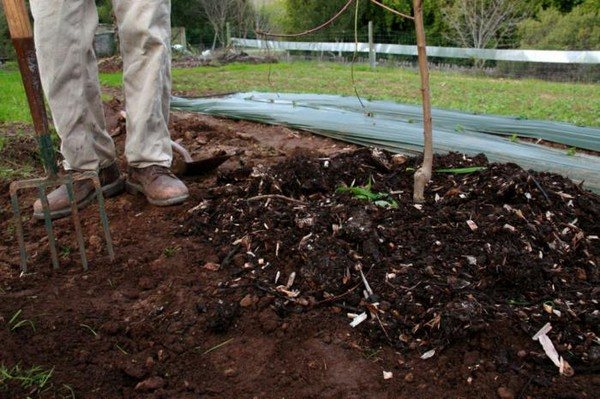

At the beginning of autumn, you need to fertilize the persimmon with phosphorus and potassium.
note! To protect adults from frost, it is advisable to use a solution of glycerin (0.05%), latex, PVA glue (30 milliliters per 10 liters of water) or Vympel and Mars preparations for processing leaves.
Plant stimulation methods


Flowering buds are formed only on the shoots of the current year, therefore, stimulation of an increase in the number of flower stalks is carried out in the year preceding flowering.
Flowering is stimulated using:
- correct watering and feeding regime;
- competent pruning of old branches;
- treatment against parasites and fungal invasions.
It is important to control the flow of moisture and nutrients, because when there is a lot of nutrition, the plant goes into growth, not into bloom. With a lack of organic matter in the soil, inhibition of both the growth and the setting of flower buds occurs.
It is possible to stimulate flowering and the formation of flowering buds with the help of phytohormones - special substances secreted by the plant itself during the period of active growth. Flowering can also be stimulated by treating young shoots with a caffeine solution, for the dilution of which tablets of caffeine-sodium benzoate are suitable.
How persimmon blooms, and what does the tree, fruits and leaves of persimmon look like in the photo
The trees, which are representatives of the Persimmon genus, will amaze you with their 8-meter height and 500 years old. Such a spreading tree requires favorable conditions.


A tree covered with persimmon looks very colorful, as if it is actually buried in lights.
On one tree there are female flowers, and on the other male flowers, which differ from each other externally. Therefore, for successful pollination, one male is required to plant next to 5-10 female trees.


Persimmon bloom is not particularly beautiful
Female flowers grow singly, while male flowers are kept together. Flowering in warmer countries begins in March, elsewhere in April or May.
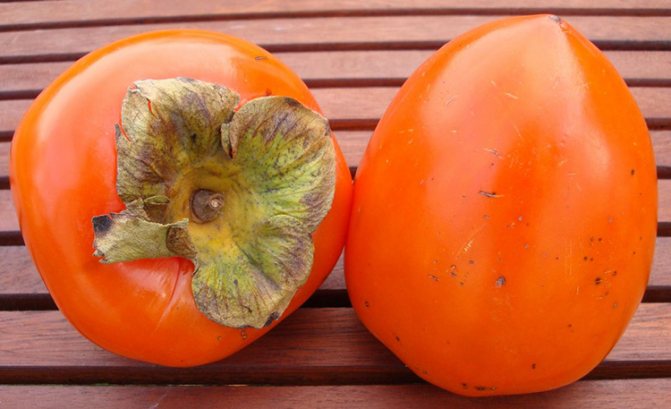

But what the fruit of a persimmon looks like: most varieties have a characteristic orange color, a spherical or elongated shape
The leaves of the tree are oval-heart-shaped, with a smooth surface and a network of veins.


The length of an adult leaf is 7 cm.By autumn, the green outfit is replaced by yellow-red
Two in one - both tasty and healthy
It often happens that tasty products are not entirely useful or even harmful, but everything turned out well with persimmon - it is extremely useful and at the same time many people like its taste. There are, of course, complaints about its astringent properties, it even makes some people refuse to use this storehouse of useful substances. The problem is completely solvable. First, choose completely ripe fruit. They have a lower content of tannin (tannin), which gives the persimmon an astringent taste. Secondly, if it was not possible to find ripe fruits, the freezer will help get rid of the astringent effect. Put persimmon there for 12 hours - and the problem is solved.
How to grow persimmons yourself?


It is quite simple to become the owner of your own fruit-bearing tree on the site. To do this, you should purchase a frost-resistant persimmon seedling, plant it and take care of it until bright ripe fruits appear.
Persimmons can be propagated by growing a ripe fruit from the seed. Unfortunately, seedlings do not retain varietal properties, therefore, grafting will be required for abundant fruiting and obtaining sweet berries of the plant.
The best stock is the Caucasian persimmon, which is characterized by increased winter hardiness, undemanding soil and endurance. The tree has a powerful fibrous root, thanks to which the plant can easily transfer transfer to a larger pot. In the spring, when the bole reaches a thickness of 1 cm, a cultivar of any kind can be grafted onto a strong seedling. On a grown tree, it is convenient to make an additional inoculation of a pollinator.
In most of Russia and in the Moscow region, growing persimmons in the open field is problematic. A short summer is not enough for the fruits to have time to set and ripen, during and after flowering there is a high risk of frost, and in winter frosts are too strong even for resistant Crimean varieties. Therefore, it is better to grow persimmons in a pot culture. In this case, it is easy to care for a tree up to one and a half meters high and, with good care, even get a good harvest.
Features of the fruit
Fruits contain a large amount of carotene, ascorbic acid, B vitamins, PP, iron, potassium, magnesium, iodine, tannins, and other biologically active compounds. Unripe pulp has an astringent, bitter taste due to the high concentration of tannins... Eating such persimmons can lead to indigestion, intestinal disorders. Long-term storage or freezing helps to enhance sweetness, change the consistency of the pulp. It becomes jelly-like, slightly spicy, like marmalade or pudding.
Persimmons can be eaten fresh and dried, as part of desserts. Jam is made from it, fruits are added to salads, sauces, meat dishes, drinks.
Persimmon is recommended for use in case of heart disease, anemia, cholecystitis, kidney pathologies. With a pronounced sweet taste, the sugar content in it is low, the calorie content is about 60 kcal per 100 g of product. Therefore, berries can be included in the diet.
Fruiting period
Summer residents who grow persimmon from stone should not wait for the rapid appearance of berries. The tree will look beautiful, but there are no big harvests in temperate climates.
Flowering and pollination
A game grows from the bone. In order for persimmon to please with fruit, they plant an shoot from a tree or shrub, which already had berries. A thermophilic culture blooms in June for the third or fourth year, but in order for an ovary to appear at home, you need to plant a pollinator nearby.


The beginning of fruiting
Even with the right place for persimmons, timely watering, adherence to a certain humidity and feeding, it is not always possible to wait for berries, growing a tropical guest in a temperate climate. The tree begins to bear fruit in the seventh year.
Fruit ripening time
Persimmon blooms late, already when warm days come, but the berries have time to fill up with juice before frost appears. In southern Russia, the fruits ripen by early November.
Harvesting and storage of crops
Persimmons are picked by hand, slightly scrolling on the stalk. Juicy berries are used for making jams and preserves, for freezing and drying. Fresh fruits are stored at 0 ° C for no more than 3 months, at room temperature - up to a week.


Harvest and storage of fruits
A few years after planting a young persimmon, it will give its first fruits. However, a decent harvest should be expected only in the fifth year of the tree's growth. Of course, this is all true if you take good care of the plant.
Important! It is not uncommon for a tree to drop its fruits. This symbolizes that the culture is not yet too strong. However, in the future, persimmon will gain strength and delight you with a good harvest of high quality and pleasant taste.
It is important to remember that the first bloom is often discarded. Do not be upset about this, as it is a symbol of good adaptation of persimmon to the environment. Also, the tree just needs to gain energy so that good fruits are set in the future.
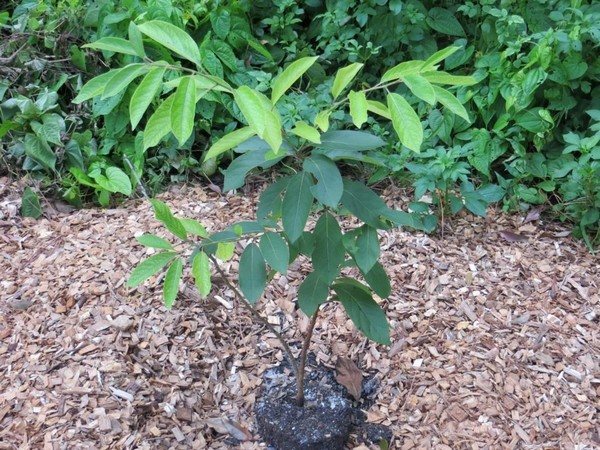

The first flowering of persimmons, as a rule, does not promise fruit, but this is normal.
Harvested by hand. They are carefully twisted on the fruit stem, otherwise you can injure the delicate skin. Since the shelf life of the fruits is only a month, it is allowed to freeze them and then sell them raw or make jams or jams from them.
If the fruits are in normal room conditions, they will quickly deteriorate. This applies even to those who did not manage to reach the required "condition". For maturation and preservation, it is required to properly organize the environment:
- maintain air humidity at 70-80%;
- the room should be dark and well ventilated;
- the air temperature should not exceed 15 degrees.


Usually persimmon fruits are not stored for a long time.
It is under these conditions that the fruits acquire softness, pleasant structure and sweet taste.
Persimmon can be used to make wonderful desserts, drinks and candied fruits. The fruits are preserved frozen or dried.
Important! Persimmon allows you to provide many vitamins to all family members in cold weather. Apart from this, the tree is really the pride of the garden. After all the trees bloom and the leaves fall off, the persimmon will still stand out with bright fruits.


Part of persimmon is used in cooking
Title [edit | edit code]
The Latin name of the genus, Diospyros, is of Greek origin and can be translated as "food of the gods", another meaning is "divine fire".
The word "persimmon" came to the Russian language from Farsi, where in the original it sounds like خرمالو khormâlu
- that is, date plum. The very word خرما
khormâ
means date, the word آلو
âlu
- plum. Name
khormâlu
originally belonged to the Caucasian persimmon. Dried persimmon tastes very much like dates, hence the name Caucasian persimmon in Farsi. Then this name spread to other types of persimmons, including the eastern (Japanese).
Species with edible fruits can be called: "wild date", "date plum".
Diseases and parasites
The fruits obtained from the Russian woman are considered environmentally friendly, because they are not processed with chemicals. There is no need to use such preparations, because the hybrid is characterized by resistance to diseases and parasites specific to fruit plants.
If you take care of persimmons incorrectly, there is a chance of encountering infections, scab or phomopsis. You can save the plant in such situations without problems if you improve the care and use a Bordeaux mixture. To get rid of diseases to the end, a couple of treatments are enough. Alternatively, you can use drugs such as Ridomil, Skor, Fundazol.


Special drugs will help get rid of diseases
Important! Young leaves can suffer from caterpillars, sucking pests - ticks and scale insects. You can cope with these parasites using insecticides "Aktara", "Aktellik".Caucasian persimmons often suffer from root cancer, so from the very beginning you need to carefully take care of it and properly organize the environment.
By the way, persimmon allows you to get rid of the effects of severe alcohol intoxication. The action is provided by antioxidants and dietary fiber, which help to remove toxic substances. The effect of these constituents is largely similar to the effect of a suspension of activated carbon.
So, Russian persimmon is a variety that can cope with various difficulties: heat, frost and severe frosts. The fruits of this type of tree are juicy, and they are also very healthy. True, you won't be able to store them for a long time. However, with proper tree care, up to 80 kg of fruit can be harvested.

